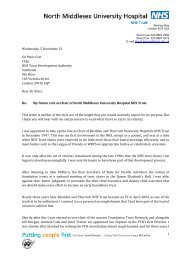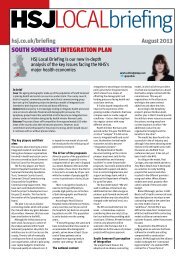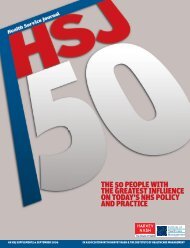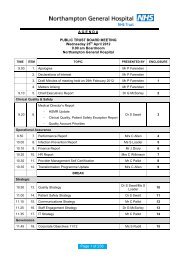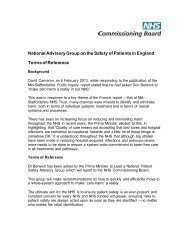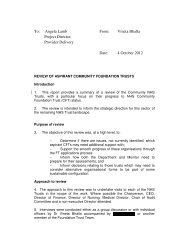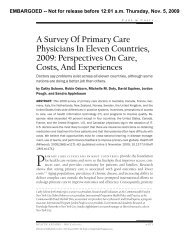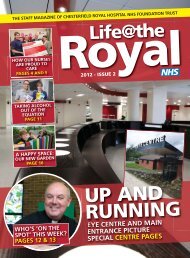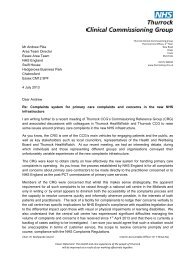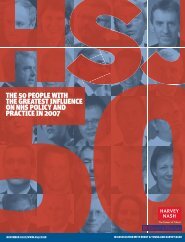Top leaders supplement - Health Service Journal
Top leaders supplement - Health Service Journal
Top leaders supplement - Health Service Journal
You also want an ePaper? Increase the reach of your titles
YUMPU automatically turns print PDFs into web optimized ePapers that Google loves.
improvement<br />
The adversarial view of making the market work for your organisation must be<br />
replaced with a system driven by a community of <strong>leaders</strong>, Jim Easton tells Jennifer Taylor<br />
swimming in<br />
the same<br />
direction<br />
Two great things have happened<br />
in NHS <strong>leaders</strong>hip over the last<br />
decade. They occurred separately<br />
but now need to be fused so that<br />
<strong>leaders</strong> can guide the service<br />
through a period of financial<br />
pressure while continuing to<br />
drive up quality.<br />
The first thing was the<br />
discipline to see through<br />
complex technical change, be<br />
that changes to waiting lists or<br />
to the experience in accident and<br />
emergency departments. It was a<br />
period characterised by<br />
information, measurement,<br />
discipline and accountability.<br />
Objectives often came top down,<br />
but they were clear.<br />
The second thing was the<br />
quality improvement movement<br />
and safety work, where<br />
improvement-type techniques<br />
were used to inspire people to<br />
lead change.<br />
In the first case, the result was<br />
widespread change for the benefit<br />
of patients. But the way it was<br />
done sometimes left staff feeling<br />
disempowered and “done to”.<br />
In the second technique there<br />
was fantastic buy-in and change<br />
was led from the bottom up. But<br />
it produced individual examples<br />
of excellence rather than<br />
wholesale change across health<br />
communities or the country.<br />
What <strong>leaders</strong> need in today’s<br />
financial environment is not a<br />
completely new set of skills, but<br />
a fusion of both of those skill<br />
sets. That will achieve the level<br />
of change, ambition and drive<br />
that was gained from the former,<br />
with the buy-in and commitment<br />
of the latter.<br />
It’s what Jim Easton, NHS<br />
national director for improvement<br />
and efficiency, calls a mature<br />
system of clinical and<br />
managerial <strong>leaders</strong>hip. He says:<br />
“If we simply revert to tough<br />
top-down management, you<br />
cannot drive quality gains in that<br />
way. Or the ones you can drive<br />
are very narrow and short lived.”<br />
But he adds: “If we simply go<br />
for just organic spread of<br />
‘We’ve had an<br />
immature view of<br />
the market: I win<br />
if you lose’<br />
interesting quality gains, we<br />
won’t survive the financial<br />
squeeze because of how quickly<br />
that comes on us and the need to<br />
make things happen at scale.”<br />
The change that’s needed<br />
won’t be driven by the individual<br />
success of organisations, where<br />
an acute trust is successful while<br />
its host primary care trust fails,<br />
or vice versa. That’s because the<br />
goal is to achieve quality and<br />
financial improvements across<br />
systems. So one of the big<br />
challenges for <strong>leaders</strong> will be to<br />
keep hold of the pride and<br />
energy that has been created in<br />
local organisations, while at the<br />
same time recognising that they<br />
are working as part of a system<br />
and the whole system needs to<br />
be successful for the components<br />
to thrive.<br />
“We’ve had quite an immature<br />
view of the market; I win if you<br />
lose,” says Mr Easton. “In the<br />
new mature system of<br />
improvement we need <strong>leaders</strong><br />
who understand that there will<br />
be times when they’re competing<br />
really hard and times when<br />
they’re working as a system to<br />
drive change that’s in the<br />
interest of patients.”<br />
Community of <strong>leaders</strong><br />
It’s unequivocally the toughest<br />
test yet for NHS <strong>leaders</strong> but<br />
managers and clinicians are full<br />
of energy and geared up to lead<br />
the change.<br />
How can those energy levels<br />
be sustained through what could<br />
be a long period of financial<br />
pressure? It’s about working as a<br />
community of <strong>leaders</strong> to keep<br />
each other on track and sustain<br />
confidence, says Mr Easton.<br />
“People will need to draw on<br />
the support of colleagues in the<br />
service because this is a long<br />
process and will involve some<br />
real challenges.”<br />
Open channels of<br />
communication are needed from<br />
the front line to the Department<br />
of <strong>Health</strong> and back again so that<br />
the right decisions can be made<br />
together. And <strong>leaders</strong> will be<br />
energised by their successes.<br />
The NHS is moving from an<br />
era that saw a fair amount of<br />
top-down driven change, and<br />
one in which there was financial<br />
growth to assist that change and<br />
to correct underfunding.<br />
In the face of forthcoming<br />
financial pressure, the DH has<br />
chosen not to throw away the<br />
commitment to quality outlined<br />
in the next stage review but to<br />
drive financial improvement by<br />
driving up quality. It’s a major<br />
<strong>leaders</strong>hip challenge for today’s<br />
NHS <strong>leaders</strong>. It’s also an<br />
opportunity to be the generation<br />
that didn’t allow the gains to<br />
evaporate during a difficult<br />
period, but used them to get<br />
through that period and secure<br />
the prize of a better NHS. l<br />
hsj.co.uk<br />
4 March 2010 <strong>Health</strong> <strong>Service</strong> <strong>Journal</strong> <strong>supplement</strong> 3



